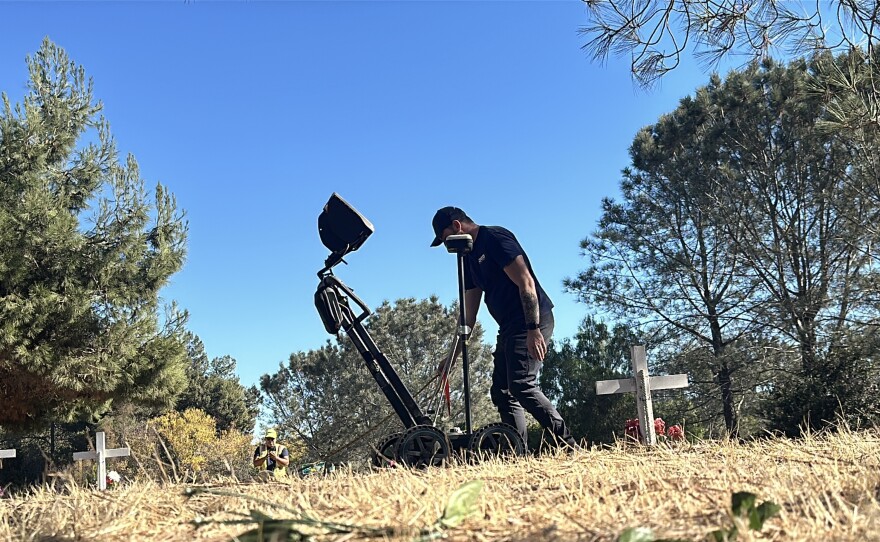It’s down a hill from St. Therese of Carmel Church, just north of highway 56. A plot of land that was used and then forgotten for a very long time.
Joe Beltran who is 96 years old rests on the seat of his walker in the cemetery. He remembers the graveyard from when he was a boy growing up in La Colonia de Eden Gardens.
“Years back when people died this is where we came to bury them, you know. And after that for a long time nobody took care of this place,” Beltran said.
He describes La Colonia as a little Mexican village in what is now Solana Beach. The overgrowth that consumed the forgotten graveyard caught the eye of Armand Olvera about 20 years ago. He’s a member of St. Therese’s church and the Knights of Columbus and he wondered what was underneath the brush.
“The brush and everything was from four to six feet high. So you couldn’t see anything in here,” Olvera said. “And so as I came down the hill and was walking through the cemetery, I tripped on one of the gravesites.”
And that was when a small community came together to clean up the cemetery and try to find out who was buried there. For Beltran it’s been like a family reunion.
“My great-grandma is in back of me over here,” Beltran said as he pointed to the spot. “My aunt is right there. My uncles are over there.”
Beltran first returned to the place about ten years ago, when he visited the graveyard with his son Michael, who remembered that day.
“My dad calls me over and says ‘I found my great grandmother.’ And that touched my heart and his, I could see the expression on his face. How glad he was to see her,” Michael said.
“So at that point we kind of made it our duty to try to do something about this cemetery.”
The Beltrans and the Knights of Columbus are part of a group that comes twice a year to clean up the graveyard that’s now called St. Therese of Carmel Cemetery.
Meanwhile, some of the history of the cemetery has been unearthed. Olvera found records at St. James Parish that indicated 83 people were buried here. So far, he said volunteers have found 57 gravesites, based on visible evidence. Some sites are marked and some are not.
“We found places where we knew there was a gravesite. So we put a white cross on those, not knowing who was there but we put a white cross,” Olvera said.
And the search is not complete because now they’re looking below ground.
Technology comes to the graveyard
Olvera said he’s wanted to scan the depths of the graveyard for years. Ultimately he and Michael Beltran made contact with the engineering and consulting firm Michael Baker International, which agreed to work on the graveyard free of charge.
Jimmy Daniels, an archeologist with Michael Baker, pushes what looks like a lawnmower across a small piece of the graveyard on a recent Saturday morning. The tool uses ground penetrating radar (GPR).

The underground images it displays look like a jumble of colors and waves to the untrained eye. But Daniels can recognize the radar signature of a likely burial, particularly when the person is buried in a casket.
“There are definitely some unmarked graves (based on) my preliminary analysis from the data from a few weekends ago. But my goal is to process all of the data and look at it as a whole,” Daniels said.
Prior to considering all the evidence, he describes his discoveries as underground “anomalies.” Sometimes they’re tree roots or gopher warrens and sometimes they are undiscovered graves.
Daniels had already marked several anomalies he found during a recent scan with blue flags on stakes. Along with the radar signature of a gravesite, above-ground evidence is also helpful to predict what you’ll find below.
He imagines a likely scenario.
“Here’s a row of burials. Here’s an anomaly that doesn't have a marker. Maybe it matches up to the other anomalies that are in that row. So we’ve got a burial there,” he said.
The act of remembering
Michael Beltran said the end goal is to identify unmarked graves and pay respects by marking them with white crosses, even if you don’t know who the person is. He said stories from the community will also play a role in their quest.
He said he spoke with a woman who thinks she knows where her sister was buried. They can scan the area to confirm it. Another story tells of two infant twins who died and were buried here. Maybe Daniels can find what appear to be two small buried coffins.
The stories often come back to La Colonia and the families that still live in the San Diego area.
+
Those original Mexican families came here in the early 20th century when local landowners were looking for people to work the citrus groves and the fields of lima beans.
“For myself, this started out as a personal journey, with my great-grandmother,” Michael Beltran said. “But as more families have started to come down and help out now, it’s turned into a community event.”
Lisa Montes is the curator of the Solana Beach Heritage Museum, located in what was La Colonia. Her uncle and grandfather are buried in the graveyard.
“My grandfather always instilled in me the importance of honoring our ancestors and never forgetting them,” Montes said.
Montes said La Colonia has changed a lot in the 100 years since it was founded. When her mother was a child she went to a segregated school for Latinos.
The old homes are mostly gone. The area has been greatly gentrified and the old families have dispersed to other parts of the county.
But the graveyard has remained a part of the community. It’s a place where people can remember the past, and maybe even find a gravesite that holds a member of the family.






